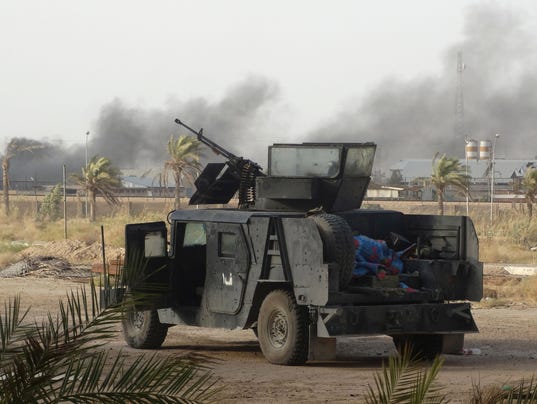WASHINGTON — In a sign of its resilience, the Islamic State appears to have recruited new fighters to offset 15,000 militants killed in a U.S.-led airstrike campaign approaching its first anniversary, U.S. military and intelligence estimates show.
More than 5,500 airstrikes by a U.S.-led coalition in Iraq and Syria that began Aug. 8, 2014, have forced the extremist organization to disperse its fighters into smaller groups, making them less of a threat to seize large chunks of territory, according to the military estimates. Despite the lethal strikes, the group continues to attract new recruits and replace leaders, highlighting the difficulty of fighting a movement that draws support from Muslims around the world.
A year ago, the CIA said it believed the Islamic State had between 20,000 and 31,500 fighters in Iraq and Syria. The estimate remains the same this year, according to a U.S. intelligence official, who asked not to be named since he was not authorized to discuss the issue.
The U.S.-led coalition confirmed the 15,000 casualty number but would not discuss it publicly. The deaths are tracked as part of daily battle damage assessments and coalition efforts to avoid civilian casualties. Aerial surveillance is used to assess the impact of airstrikes, including enemy casualties.
One reason the military does not trumpet enemy death estimates is lingering embarrassment from the Vietnam War, when the Pentagon announced daily enemy death figures as a sign of military progress. Yet those counts proved to be exaggerated and U.S. troops ultimately withdrew from Vietnam, having failed to defeat the army of communist North Vietnam .
In the current conflict, the U.S. military has warned that casualty numbers are a poor measure of progress in the conflict. Gen. Martin Dempsey , chairman of the Joint Chiefs of Staff, told American servicemembers in Iraq this month that battling the Islamic State will last for years and will involve countering its brutal ideology in addition to battlefield showdowns.
Commanders said the daily air campaign, combined with successes on the ground by Iraqi and Kurdish forces, have weakened the militant organization and reversed the increasing strength it once enjoyed. “The tide of momentum has begun to creep against them,” said Brigadier James Learmont, a British coalition official in Baghdad.
When Islamic State militants swept through Iraq last year, capturing the country’s second-largest city of Mosul in June, they appeared invincible. Now “there is a sense of paranoia that is starting to creep into their rank and file,” Learmont said, adding there is evidence militants are being assassinated if they attempt to desert.
Military analysts disagree about the wisdom of withholding casualty counts. “If that was a good measure we would have won the Vietnam War,” said Andrew Krepinevich, an analyst at the Center for Budgetary Assessments. “Body counts didn’t work. They don’t show any signs of running out of people.”
But others say it is at least one measure of progress. “The magnitude of that number is pretty damn big,” said David Deptula, a retired Air Force lieutenant general who served as deputy Air Force chief of staff for intelligence, surveillance and reconnaissance. “It does have an enormous psychological impact” on the enemy.


0 komentar:
Posting Komentar